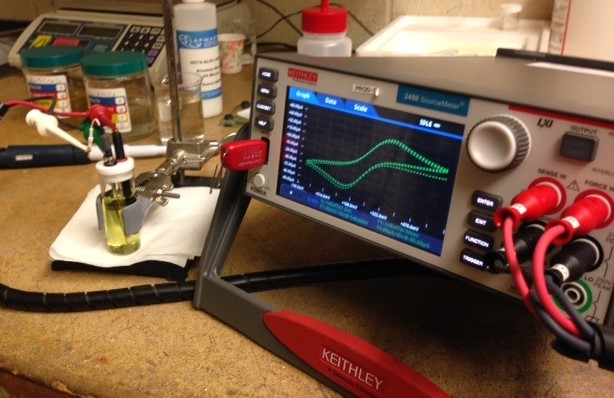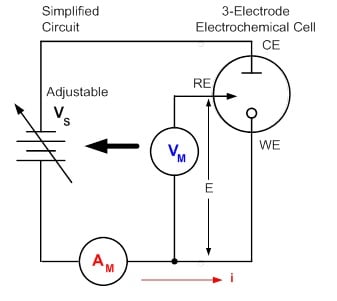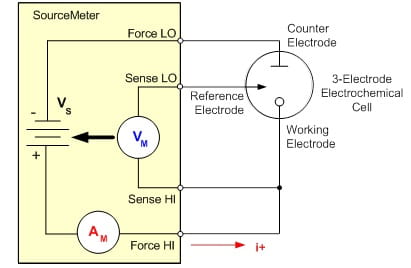


I have often been asked if it is possible to perform cyclic voltammetry, one of the most commonly used electrochemistry measurement techniques, with a source measure unit (SMU). SMU Instruments measure and source both current and voltage, which make them an alternative to today’s potentiostats. Cyclic voltammetry (CV), a type of potential sweep method, typically uses a 3-electrode cell. Figure 1 illustrates a typical electrochemical measurement circuit made up of an electrochemical cell, an adjustable voltage source (VS), an ammeter (AM) and a voltmeter (VM). The three electrodes of the electrochemical cell are the working electrode (WE), the reference electrode (RE), and the counter electrode (CE). The voltage source (VS) for the potential scan is applied between the working electrode and the counter electrode. The potential (E) between the RE and WE is measured with the voltmeter, and the overall voltage (VS) is adjusted to maintain the desired potential at WE with respect to RE. The resulting current (i) flowing to or from WE is measured with the ammeter (AM).

Figure 1. Simplified measurement circuit for performing cyclic voltammetry
Because Keithley SMUs (also known as SourceMeters®) source voltage and measure current, in themselves a potentiostat, they are well suited to perform cyclic voltammetry. Figure 2 illustrates how the instrument’s four terminals are connected to the 3-electrode electrochemical cell.

When an SMU is programmed to source voltage in the remote sense (4-wire) configuration, internal sensing provides a feedback voltage that is measured and compared to the programmed level. The voltage source is adjusted until the feedback voltage equals the programmed voltage level. Remote sensing compensates for the voltage drop in the test leads and analyte, ensuring that the programmed voltage level is delivered to the working electrode.
The Model 2450-EC and 2460-EC Potentiostats, based on SMU technology, have a built-in display that can plot a voltammogram automatically using a cyclic voltammetry script. Figure 3 shows a voltammogram generated on the Model 2450-EC. In addition to measuring cyclic voltammetry, the user can also perform linear sweep voltammetry, chronopotentiometry, and open circuit potential measurements.

Figure 3. Generating a voltammogram on the display of the Model 2450-EC Potentiostat
You can learn more at this related blog: How Source Measure Units can be used as Potentiostats for Cyclic Voltammetry, Chronoamperometry and other Electrochemical Tests
For more information on the products discussed in this blog, click on the following links:
Further information on using the Model 2450-EC or 2460-EC Potentiostats for cyclic voltammetry can be found in the application note, “Performing Cyclic Voltammetry Measurements Using Model 2450-EC or 2460-EC Electrochemistry Lab Systems”.


